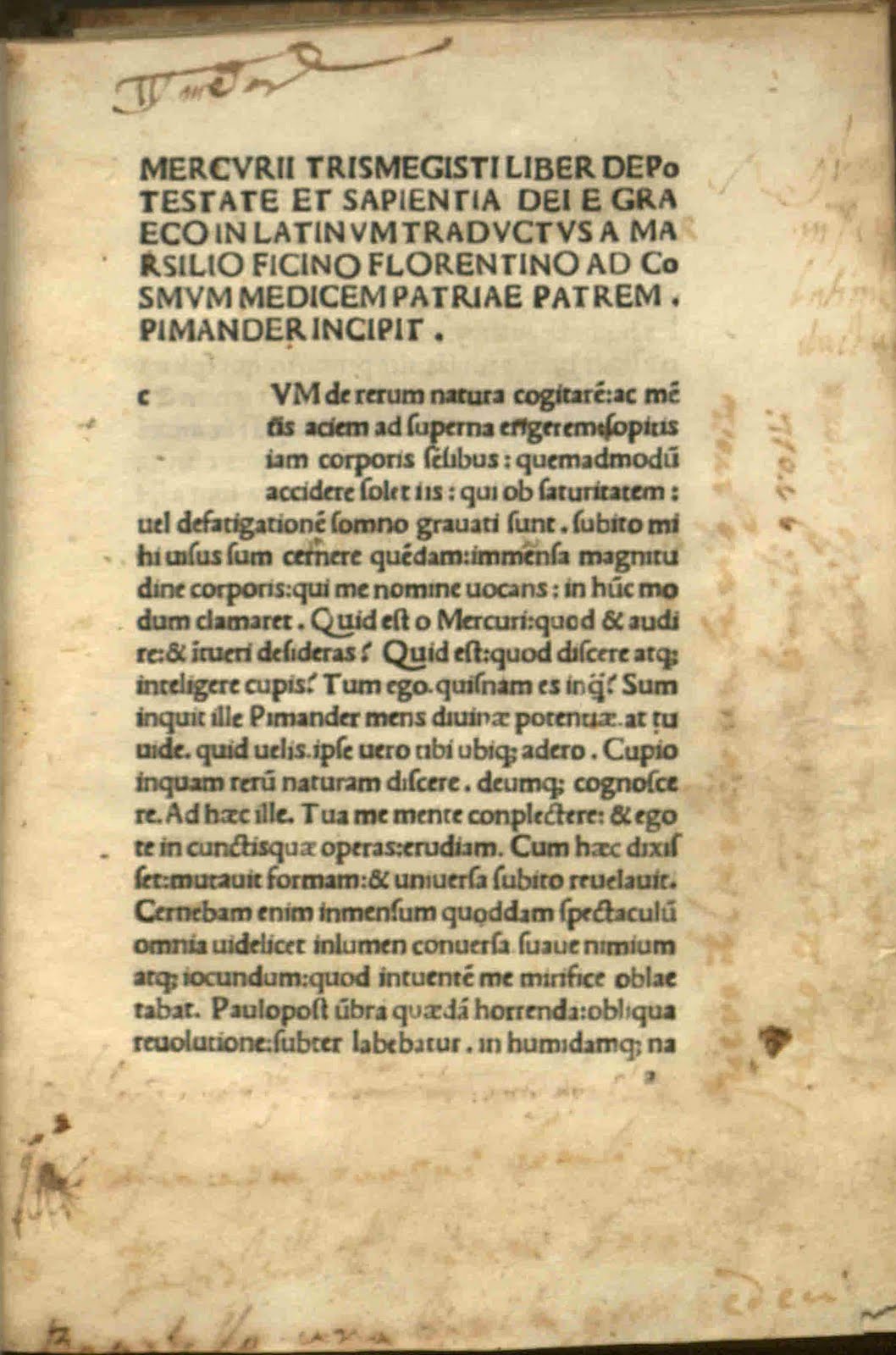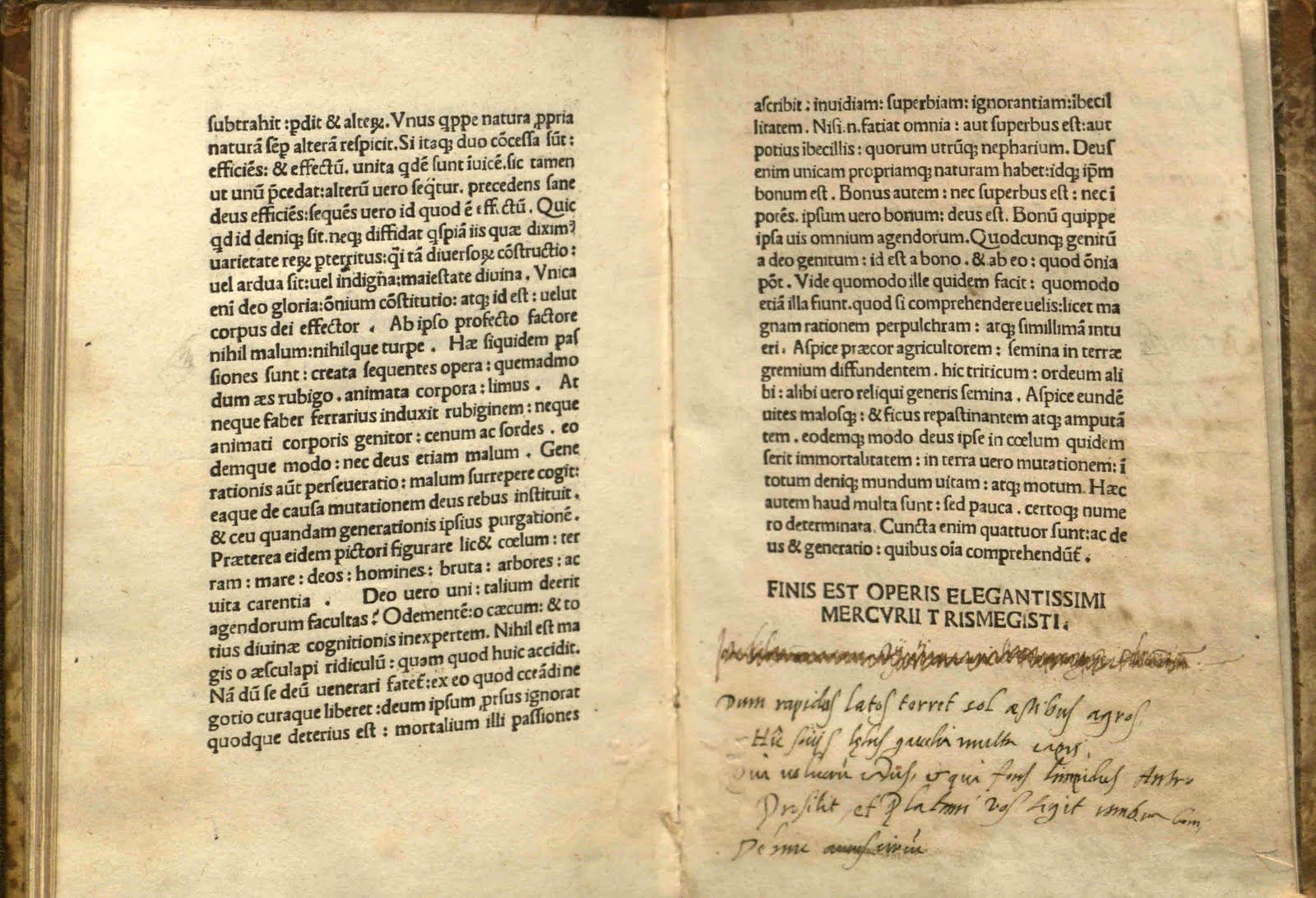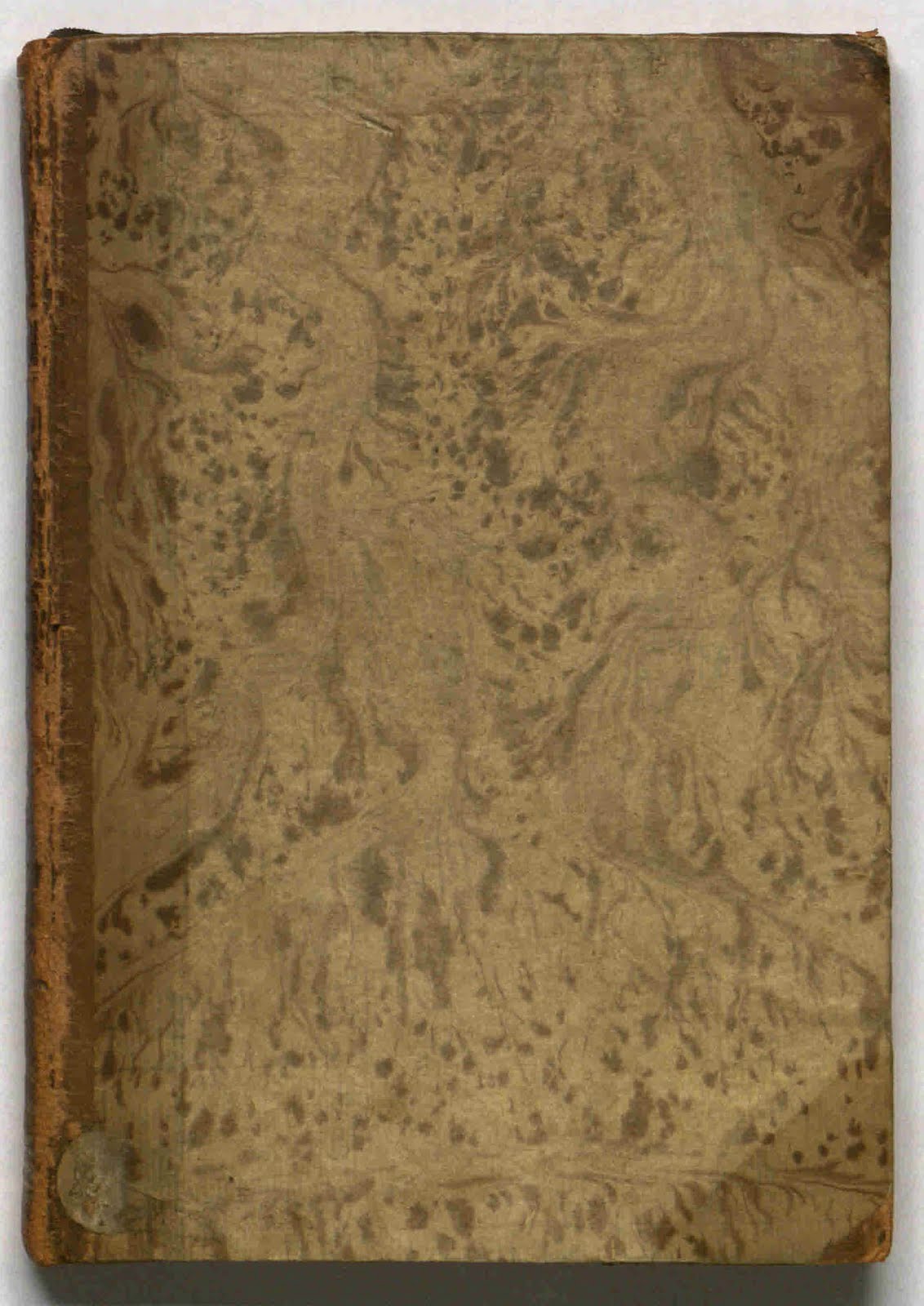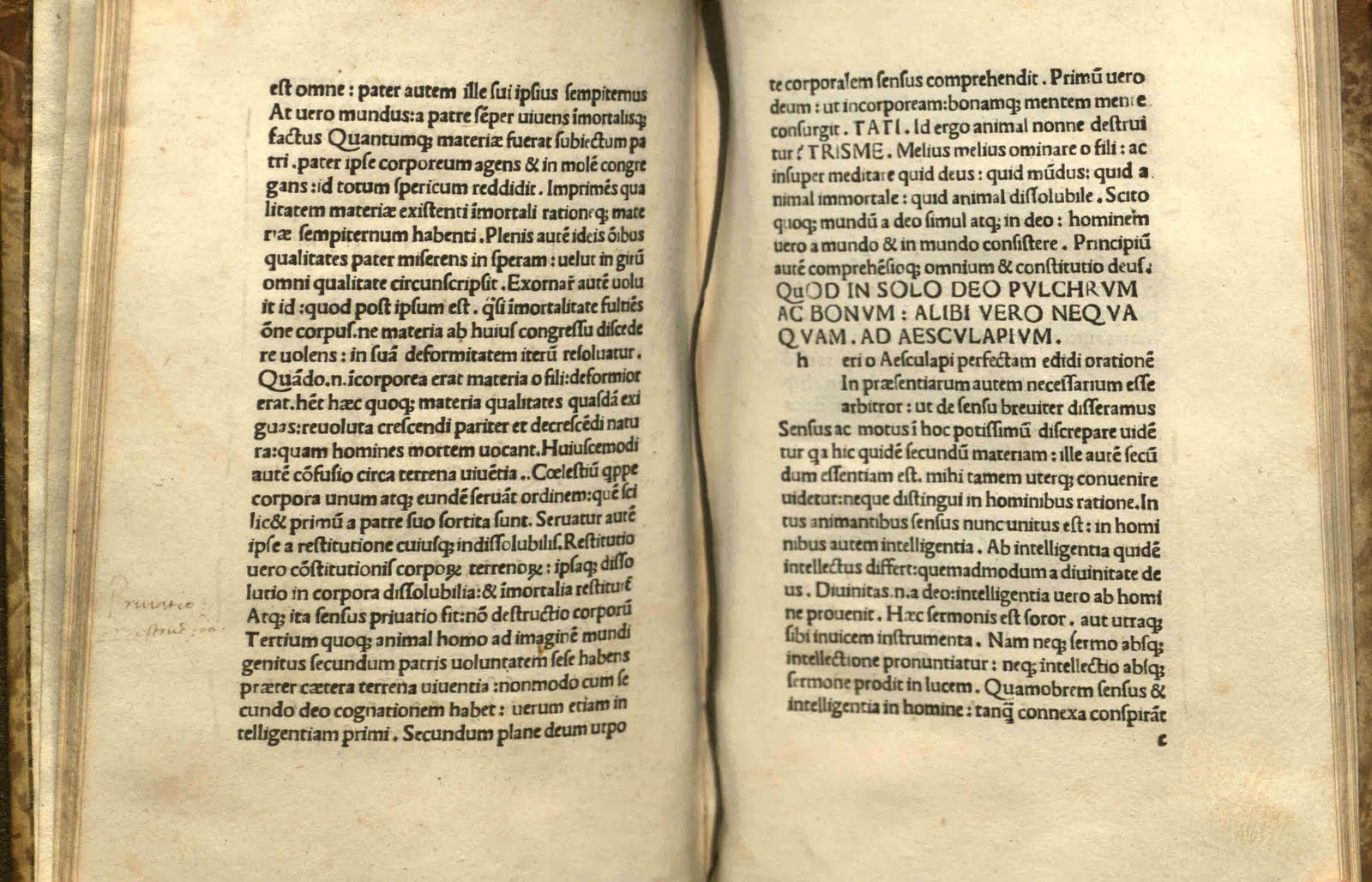Pimander, Sive De Potestate et Sapientia Dei
November 17, 2009
Description by Rev. Donald Donato, Assistant Rector at the Parish of St. Sarah the Egyptian of the Apostolic Johannite Church
 Pimander, sive De potestate et sapientia Dei is the title of a Hermetic work in Latin that comprises all of the known Corpus Hermeticum with the exception of the last three tractates. The Corpus (and this translation) is a series of Hellenistic Egyptian mystical works attributed to Hermes Trismegistus, whose tradition may have begun with the veneration of the Egyptian god Thoth[1]; he was later identified with the Greek Hermes. The Corpus is one of the most important sources of inspiration for the Western Esoteric Tradition.
Pimander, sive De potestate et sapientia Dei is the title of a Hermetic work in Latin that comprises all of the known Corpus Hermeticum with the exception of the last three tractates. The Corpus (and this translation) is a series of Hellenistic Egyptian mystical works attributed to Hermes Trismegistus, whose tradition may have begun with the veneration of the Egyptian god Thoth[1]; he was later identified with the Greek Hermes. The Corpus is one of the most important sources of inspiration for the Western Esoteric Tradition.
The latter sections of the Corpus were well known throughout Europe and the Near East during the Middle Ages, making Pimander a novelty to Renaissance scholarship when it was first published in 1463. The Robert D. Farber University Archives and Special Collections at Brandeis is home to an example of the third edition, one of the eight editions of the Corpus published before 1500.[2] This edition of Pimander, printed in Venice by Lucas Dominici (1481), was rebound in 1700, according to the description and provenance narrative inserted when the incunable was given to Brandeis. This edition was a gift of Bern Dibner, an early donor to the university and chairman of the Society of Bibliophiles at Brandeis.
 The content of Pimander is philosophical, theosophical, astrological, magical and alchemical, and was likely assembled during the second and third centuries CE. In addition to this 15th-century translation, Coptic fragments of the Corpus were found at Nag Hammadi, Egypt, in 1945.[3] The provenance of this incunable indicates that it was owned by the physician Georgius Kloss. This copy is in excellent condition, although it appears to have been trimmed to be rebound. The typography is in the Roman style, with spaces left at the beginning of leading paragraphs for illuminations that were never added. There are a number of pages that contain handwritten notes in Italian. The margin notes are likely from before the 18th century, given that some of them were lost when the book was trimmed and rebound.
The content of Pimander is philosophical, theosophical, astrological, magical and alchemical, and was likely assembled during the second and third centuries CE. In addition to this 15th-century translation, Coptic fragments of the Corpus were found at Nag Hammadi, Egypt, in 1945.[3] The provenance of this incunable indicates that it was owned by the physician Georgius Kloss. This copy is in excellent condition, although it appears to have been trimmed to be rebound. The typography is in the Roman style, with spaces left at the beginning of leading paragraphs for illuminations that were never added. There are a number of pages that contain handwritten notes in Italian. The margin notes are likely from before the 18th century, given that some of them were lost when the book was trimmed and rebound.
Pimander, also known as “The Divine Pymander” or Poimandres, is a diverse system of mystical writings influenced by Egyptian, Jewish, Greek, Gnostic and Christian ideas, but commonly accredited to the mystagogue Hermes Trismegistus. In Greek, the name of this enigmatic figure means “Thrice-Great Hermes” (Mercurius ter Maximus in Latin); he is believed to have lived just after Moses, although the fundamental principles contained in these writings may represent a very ancient Memphite tradition dating from at least the eighth century BCE.[4]
 Florentine Duke Cosimo de’ Medici commissioned Marsilio Ficino to translate Pimander into Latin from a Greek manuscript brought from Macedonia. Ficino was a leading force within the newly established Neo-Platonist Academy, a respected scholar, a Catholic priest and, by his own and other accounts, openly homosexual. It is striking that Ficino was placed in such an important scholarly and religious capacity given his sexuality, and it is noteworthy that the ideas contained within Pimander provide an understanding of humanity that was markedly more inclusive than the prevailing atonement theology of the day.
Florentine Duke Cosimo de’ Medici commissioned Marsilio Ficino to translate Pimander into Latin from a Greek manuscript brought from Macedonia. Ficino was a leading force within the newly established Neo-Platonist Academy, a respected scholar, a Catholic priest and, by his own and other accounts, openly homosexual. It is striking that Ficino was placed in such an important scholarly and religious capacity given his sexuality, and it is noteworthy that the ideas contained within Pimander provide an understanding of humanity that was markedly more inclusive than the prevailing atonement theology of the day.
Ficino finished his translation in 1463. Within a few years Ficino translated several other pivotal texts that would lay the foundations for Humanist studies, including the works of Plato and the Christian Neo-Platonist Dionysius the Areopagite.[5]
Hermes Trismegistus was respected and referenced by early Christians, such as Augustine of Hippo and Lactantius.[6] Augustine wrote:
As regards philosophy, which professes to teach men something which shall make them happy, studies of that kind flourished in those lands about the times of Mercury, whom they called Trismegistus, long before the sages and philosophers of Greece, but yet after Abraham, Isaac, Jacob, and Joseph, and even after Moses himself. At that time, indeed, when Moses was born, Atlas is found to have lived, that great astronomer, the brother of Prometheus, and maternal grandson of the elder Mercury, of whom that Mercury Trismegistus was the grandson.[7]
For this reason the translation of the Corpus was given the highest priority by Medici. Ficino named the entire work “Pimander,” a title meaning “Shepherd of Men,” but in fact that name is but one chapter in the entire Corpus.[8]  Both Medici and Ficino were convinced that the works attributed to Hermes Trismegistus were far older than those of Plato, whose works were put aside to complete Pimander. Ficino’s translation cultivated a theme within Renaissance scholarship that identified the Egyptian roots of this Hellenistic philosophy. The essence of the mystical teachings contained within Pimander articulates a divinity that may be understood and experienced through nature. Moreover, the spirit of Pimander clearly describes the material universe, including the human body, as a model for a creative process, and not the source of damnation.[9] This concept flourished in the new arts and sciences characteristic of Ficino’s age.
Both Medici and Ficino were convinced that the works attributed to Hermes Trismegistus were far older than those of Plato, whose works were put aside to complete Pimander. Ficino’s translation cultivated a theme within Renaissance scholarship that identified the Egyptian roots of this Hellenistic philosophy. The essence of the mystical teachings contained within Pimander articulates a divinity that may be understood and experienced through nature. Moreover, the spirit of Pimander clearly describes the material universe, including the human body, as a model for a creative process, and not the source of damnation.[9] This concept flourished in the new arts and sciences characteristic of Ficino’s age.
Expanded knowledge of the ancients gave rise not only to alchemy, astrology and, later, to their corresponding physical sciences, chemistry and astronomy, but also to Humanism and the dramatic shift of European thought towards a human-centered perspective on spirituality, science, ethics and politics. The printing of Pimander, among which this incunable is a very early example, sent shockwaves of conceptual progress throughout the continent, shaping the way we think even today.
Notes
- J. Robinson, ed., “Asclepius,” in Nag Hammadi Library in English, introduced and translated by J. Brashler, P. Dirkse and D. Parrott (Leiden: E.J. Brill, 1977; San Francisco: HarperSanFrancisco, 1988): 330.
- see George Sarton, review of Hermetica by Walter Scott in Isis 8, no. 2 (May, 1926): 343-346, at 345.
- W. Barnstone and M. Meyer, eds., “Poimandres,” in The Gnostic Bible (Boston: Shambala Press, 2003), 502.
- Karl W. Luckert, Egyptian Light and Hebrew Fire (Albany: State University of New York Press, 1991), 100-102.
- Charles Garfield Nauert, Humanism and the Culture of Renaissance Europe (Cambridge: Cambridge University Press, 1995), 61.
- Frederick Purnell, Jr., “Hermes and the Sibyl: A Note on Ficino’s Pimander,” Renaissance Quarterly 30, no. 3 (Autumn, 1977).
- Augustine, De Civitate Dei (The City of God), ed. Philip Schaff, trans. Rev. G. Wilson & Rev. J.J. Smith (New York: Christian Literature Publishing Co., 1886), Book VIII, 39.
- Peter French, John Dee: The World of an Elizabethan Magus (London: Routledge & Kegan Paul, Ltd., 1972, 1984), 66.
- Michael Allen and Valery Rees, eds., with Martin Davies, Marsilio Ficino: His Theology, His Philosophy, His Legacy (Leiden and Boston: Brill Academic Publishers, 2002), 291.